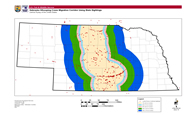Wind
Wind Power Development in Nebraska
Cooperative Whooping Crane Tracking Project
The whooping crane tracking project relies on landowners, volunteers, and biologists throughout the central flyway that report whooper sitings to the Service during the spring and fall migrations. The Service records the sitings and has compiled up to 40 years of fall migration data. This data benefits both scientists and project proponents. For example, this data will be used to help wind companies determine where wind development should occur to minimize impacts to migrating whooping cranes.
Confirmed Whooping Crane Sightings.

Confirmed Whooping Crane Sightings and Migration Corridor in Nebraska
USFWS Wind Power Siting Guidelines
The U.S. Fish and Wildlife Service (Service) has provided a released the final Land-Based Wind Energy Guidelines. These guidelines are U.S. Fish and Wildlife Service's recommendations on measures to take to avoid, minimize, and compensate for effects to fish, wildlife, and their habitats. They were designed to help developers avoid and minimize impacts of land-based wind projects on wildlife and their habitats.
Final Land-Based Wind Energy Guidelines
Land-Based Wind Energy Guidelines Factsheet
Renewable Energy Facts for Nebraska
- Nebraska ranks sixth nationally among states with the most potential for wind development.
- The total wind energy potential in Nebraska is 30,000 megawatts.
- Nebraska’s Governor and State Legislature have made renewable energy a top priority.
- Nebraska’s current energy capacity from all sources is 6,000 megawatts.
- A single wind turbine is capable of producing 3 megawatts.
- Guidelines for wind energy development have been developed for the state of Nebraska
Wind Energy and Nebraska's Wildlife
Inter-Regional Central Flyway Habitat Conservation Plan
Nineteen wind energy companies (the Wind Energy Whooping Crane Action Group known as "WEWAG") are developing Great Plains Wind Energy Habitat Conservation Plan in collaboration with the Service and state agencies. The plan's goal is to provide conservation measures for whooping cranes (Grus americana), interior least terns (Sterna antillarum athalassos), piping plovers (Charadrius melodus), and the lesser prairie-chicken (Tympanuchus pallidicinctus), across nine states where wind development is proposed for the great plains.
Great Plains Wind Energy
Great Plains Wind Energy Project Fact Sheet
Species Included in the Great Plains Wind Energy HCP
Great Plains Wind Energy Habitat Conservation Plan website









